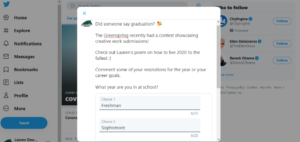
I choose Twitter because it is, in my opinion, the second commonly used social media platform after Instagram. Most students in college use either Instagram or Twitter as their main source of fast news or information. I think that Twitter is slightly easier to access and set up for all age groups. In particular for reading my piece, college students in general can relate the most to the theme of my poem.
For Twitter, I will use text as a caption with a character limit of 280 characters. I can manipulate the color of the text directly in the app but would have to use a third-party to change the font. I will use both emojis and punctuation because they are commonly used amoungst my age group and will draw in the audience. Both can make a simple tweet to something students will remember and make them want to take further action. I will also sometimes use graphics rather than constant text.
Twitter is a straight forward platform that often contains few words. This is another reason why I choose it. Therefore, each of my posts will not contain many words but will promote the Greenspring Review interactively through polls, images, and links. This is how many authors tend to promote written work through Twitter.
Since posts contain few words, users are often continuously scrolling through Twitter for more content. Therefore, I will post on Twitter often with at least 5 posts a day. My audience uses Twitter during business hours which is between 9 a.m. to 4 p.m. This also relates to business days which are Monday and Thursday, posting sometimes on Fridays. I will increase likes and comments by posting during this timeframe and these days. I will also use hashtags so that users can see my posts even if they do not follow the Greenspring Review account. I also interact with those who like, retweet, and comment on my posts. Encouraging others to share the account as well as promoting it on other social media platforms will help build the Greenspring Review’s Twitter page.
